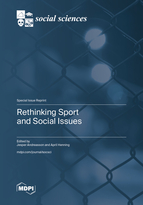Rethinking Sport and Social Issues
A special issue of Social Sciences (ISSN 2076-0760).
Deadline for manuscript submissions: closed (1 September 2023) | Viewed by 26085
Special Issue Editors
Interests: gender studies; the sociology of sport; gym/fitness culture; body studies
Special Issues, Collections and Topics in MDPI journals
Interests: women and sport
Special Issues, Collections and Topics in MDPI journals
Special Issue Information
Dear Colleagues,
This special issue aims to bring together interdisciplinary discussions and analyses on contemporary sport, its transforming nature, and social issues connected to our way of understanding both sport and broader social life. With “rethinking sport” we want to emphasize the ever-changing nature of sport. Historical and contemporary sport is not a fixed phenomenon, rather it develops in relation to culture and society, turning into future sport. In the wake of the COVID-19 pandemic, for example, new lifestyles and habits have evolved in the form of virtual solutions, interrupted or modified sport seasons and events, changes to how sport is practiced, and more. There are also new sports constantly evolving, as sportification processes in society may challenge our understanding of what constitutes sport and what does not. Rethinking sport thus also means embracing perspectives in which social and cultural change occur. Such changes may be particularly relevant when direction the attention to social issues of sport. The term “social issues,” is here understood broadly, and in this volume we want to emphasize how sport may counter or create inequalities and social injustices. We are interested in (but not limited to) analyses on sexual abuse in sport, intersectionality, human rights, subcultures, drug use, inclusion/exclusion, race and racialization, and economic inequalities. The issue welcomes contributions from a wide variety of perspectives and disciplines including sociology, sport science, social work, cultural studies, gender studies, pedagogy, and more.
Dr. Jesper Andreasson
Dr. April Henning
Guest Editors
Manuscript Submission Information
Manuscripts should be submitted online at www.mdpi.com by registering and logging in to this website. Once you are registered, click here to go to the submission form. Manuscripts can be submitted until the deadline. All submissions that pass pre-check are peer-reviewed. Accepted papers will be published continuously in the journal (as soon as accepted) and will be listed together on the special issue website. Research articles, review articles as well as short communications are invited. For planned papers, a title and short abstract (about 100 words) can be sent to the Editorial Office for announcement on this website.
Submitted manuscripts should not have been published previously, nor be under consideration for publication elsewhere (except conference proceedings papers). All manuscripts are thoroughly refereed through a double-blind peer-review process. A guide for authors and other relevant information for submission of manuscripts is available on the Instructions for Authors page. Social Sciences is an international peer-reviewed open access monthly journal published by MDPI.
Please visit the Instructions for Authors page before submitting a manuscript. The Article Processing Charge (APC) for publication in this open access journal is 1800 CHF (Swiss Francs). Submitted papers should be well formatted and use good English. Authors may use MDPI's English editing service prior to publication or during author revisions.
Keywords
- intersectionality
- inclusion/exclusion
- human rights
- drug use
- diversity
- sexual abuse
- indigenous sport
- COVID-19







